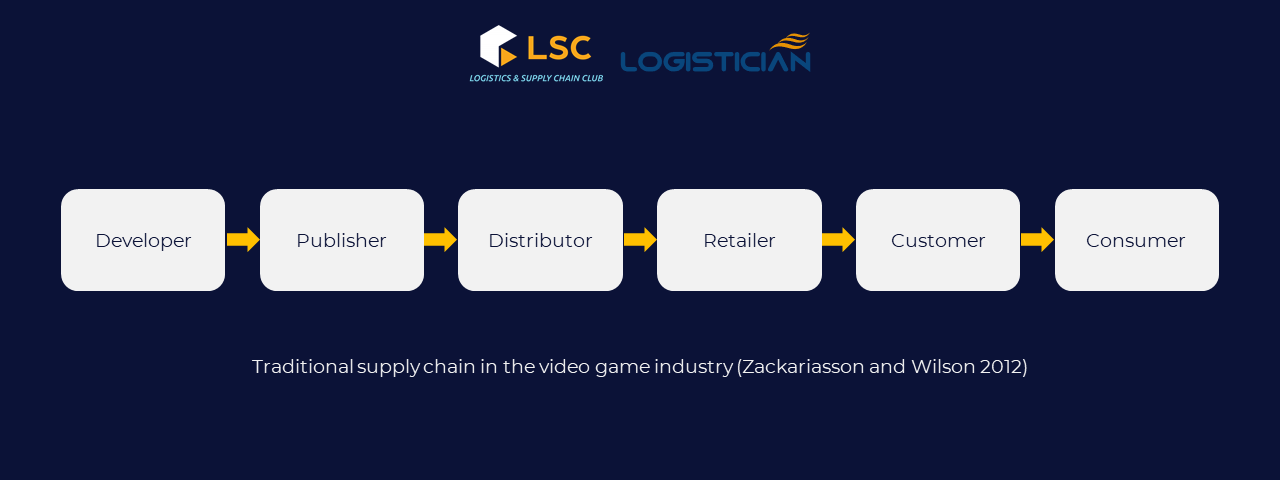The development of the gaming industry
The gaming industry has undergone a massive evolution since the 1970s, changing from being a unique activity into a mainstream one; from PC, Console, and mobile gaming platforms to VR and Cloud Gaming.
Early video games were created at academic laboratories in the early of the 20th century. However, it wasn’t until the late 1970s and early 1980s that customers began to widely own video game consoles and computers to play a range of video games. The “video game crash of 1983” saw a decline in the home video game console market, which was commonly linked to poor quality hardware releases. After that, the game industry grew significantly in Japan and a new generation of home video game consoles was born. At the same time, home computers as video game platforms remained popular and diverse until the late 1990s, which saw IBM clones become the dominant home computing platform.

Supply Chain in the Gaming Industry

Steps in the gaming industry supply chain include:
- Identification of the vendors – Locate software & hardware vendors in the supply chain include code development, UHD (ultra-high-definition) software products, storage devices.
- Manufacturing – including steps like DVD, Blu-ray & CD replication and finished product packaging.
- Packaging & Hardware Bundling – including software bundling of Nintendo (switch & 3DS), PS5, Xbox One, etc., and hardware bundling of Toys to Life (game), Postponement.
- Logistics & Distribution – including Media & Merchandise and B2B & B2C relationship building. Also include Key services like Pick, Pack & Ship, Warehousing, Logistics, Returns Processing Display Assembly
The development of technology resulted in a significant shift in the traditional distribution of video games. Now, the process of disintermediation is following in the supply chain network and few organizations have been removed from the supply chain. Therefore, digital distribution blurred the role of publishers, distributors, and retailers, and even consumer and process has become lean and resilient.
Game industry value chain

Traditionally, the video game industry has had six connected layers in its value chain based on the retail distribution of games:
- Game development: represents programmers, designers, and artists, as well as their leadership, with the support of middleware and other development tools.
- Publishing: often includes funding to develop the video game, as well as providing marketing and advertising for the game.
- Distribution: whether through retail or digital channels. Distribution typically includes the production and cloning of game vehicles and packaging for retail games.
- Retailer: the storefront where the game is sold.
- Customers and consumers: buyers and players of video games
- Hardware/platform manufacturers: may own and place limits on content on the platform they have created, requiring developers or publishers to pay licensing fees to release games on that system.
As games transition from retail to more digital, parts of this value chain become redundant. For example, a distributor may be redundant as a function of the publisher or retailer, or even in some cases like indie games, the developer’s own function.
Key challenges of Supply Chain in the gaming industry
The industry faces chip shortages, especially during supply chain disruptions due to the COVID19 pandemic. Chips play a very important role in the gaming industry, and the PS5 and Xbox both run on chips from Advanced Micro Devices (AMD). This chip shortage has increased the price of Nvidia graphics cards and other chips used in gaming.
Technological Evolution: In the face of fast advancing technology, game firms are constantly under pressure, since fluctuating consumer habits and a lack of regulation makes it tough to compete in the marketplace.
Localization: Economic and cultural forces have a significant impact on the game business. Game localization will incur financial costs as well as jeopardize the game’s concept integrity. Rather than forcing local cultures to adapt foreign items, companies are instead producing and selling products that can be adapted to local markets.
Excessive Vendor Reliance: Many game companies rely on specific vendors to fulfill their needs, which leads to a lack of progress in game design and development.
Van Anh
FURTHER READING
Supply chain management: The key for the era of space exploration












